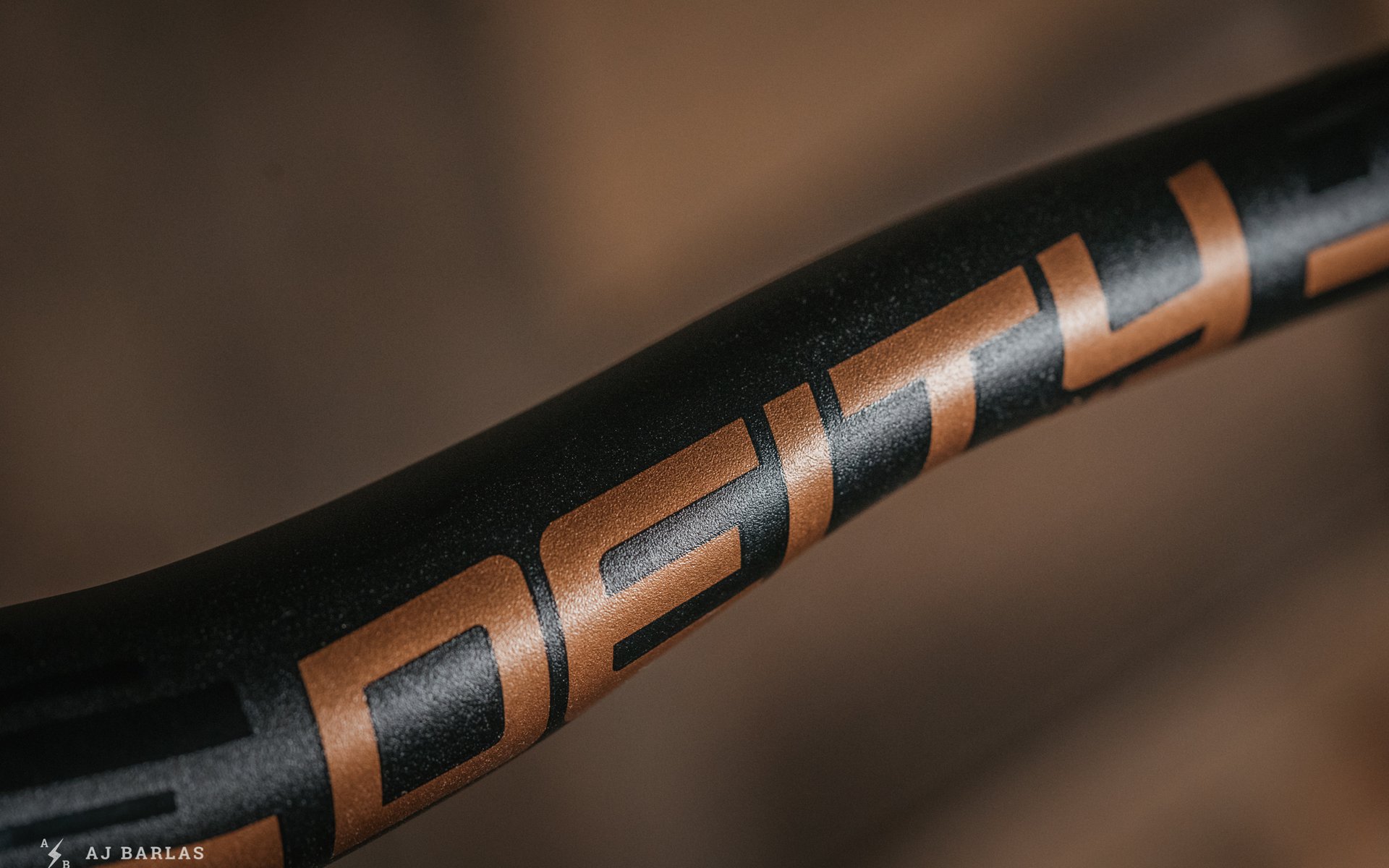
Review
Deity 35mm Handlebar Range Compared
Of all changes with “standards”, or dimensions for mountain bike components, the move to 35mm diameter handlebars has probably been the slowest in recent memory. Since the larger diameter bars first began to trickle onto the market we’ve come dangerously close to the full extinction of 26-inch wheels and the 10x135mm hub width. Four-piston brakes are now close to standard on all-mountain trail bikes, where a 35mm bar may be found, and rims suitable for smashing often start around the 27–30mm internal width.
But handlebars remain a mixed bag. Many brands still offer 31.8mm clamp diameter bars and stems, and not just in their budget lines. For a few brands, the move to 35mm has been a reluctant one and some are rumoured to have been produced purely to service demand. It’s funny, and at times frustrating, how the marketing world of mountain bikes can influence what we ride, even when the benefits are questionable.
Deity is one of the reluctant brands. In their words, "it is all about the feel of a handlebar” and they say considerable time was spent getting their 35mm bars to ride the same as their 31.8mm counterparts before offering them to consumers. So if the intention is to offer 35mm bars that ride the same as their already available 31.8mm equivalents, why bother at all? For Deity, moving to the larger clamp diameter made it possible to provide a wider bar, at less weight while maintaining strength. With many of their new bars measuring wider than the 31.8mm equivalent and weighing less, they appear to have won that argument.
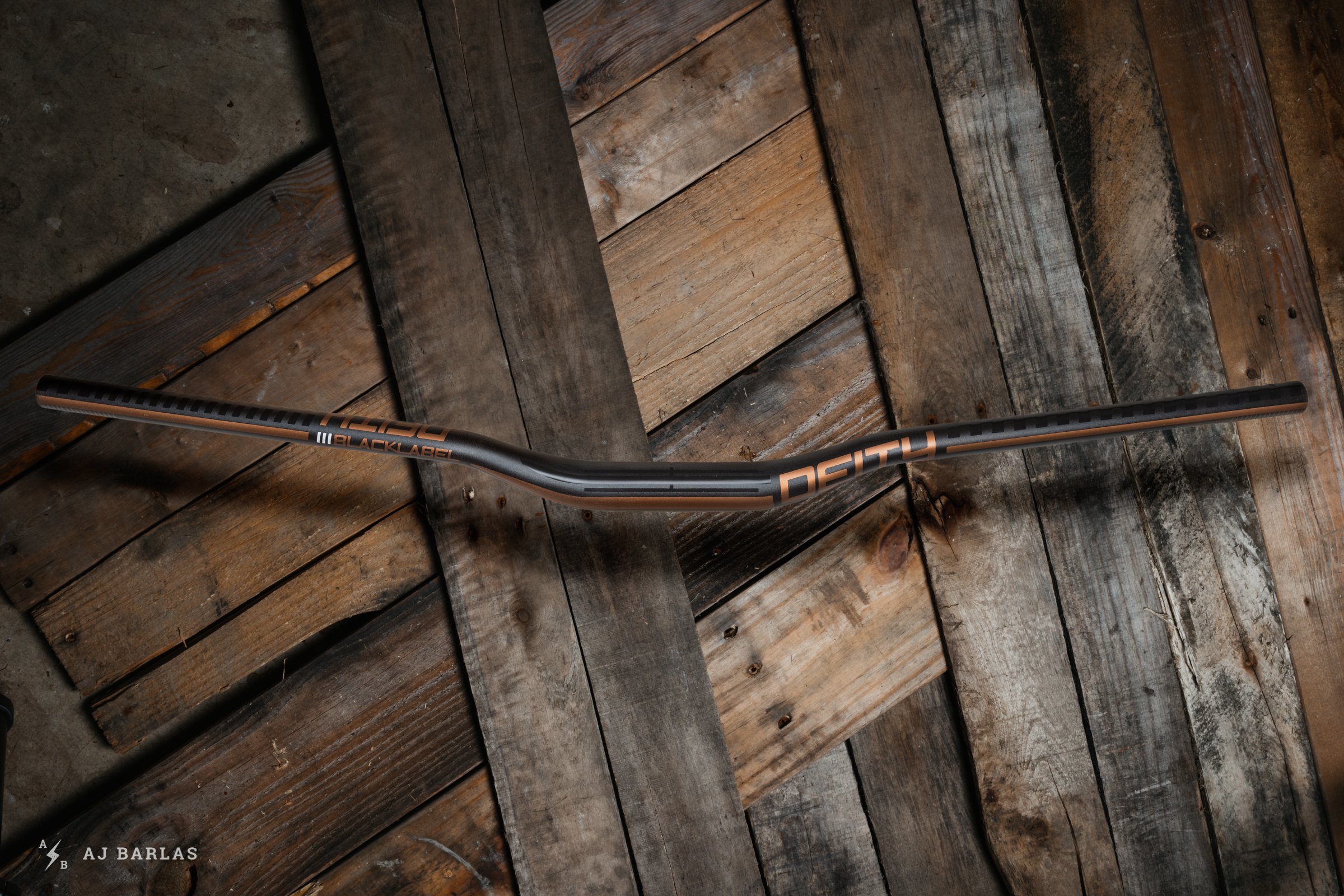
Deity's Blacklabel handlebar has been where my hands call home for some time now.
Benchmarking with the Deity Blacklabel Handlebar
800mm wide • 25mm rise • 7075 T73 aluminum w/ Gradient Butting Technology • Weight: 347g
I’ve spent the last four years riding the Blacklabel bar from Deity. I appreciate the combination of bar geometry and ride feel and despite spending time on others, I’ve always gone back. I’ve ridden them in 25mm and 38mm rise, uncut at 800mm and cut to 780mm. They've been consistent in ride quality in every version. They’re comfortable and they prevent hand fatigue or arm pump, after long, rough, non-stop runs or in high-frequency chatter. On the rare occasion I’ve suffered hand fatigue with the Blacklabel, it's coincided with a new component (brakes, grips, wheels), or stiffer suspension setting.
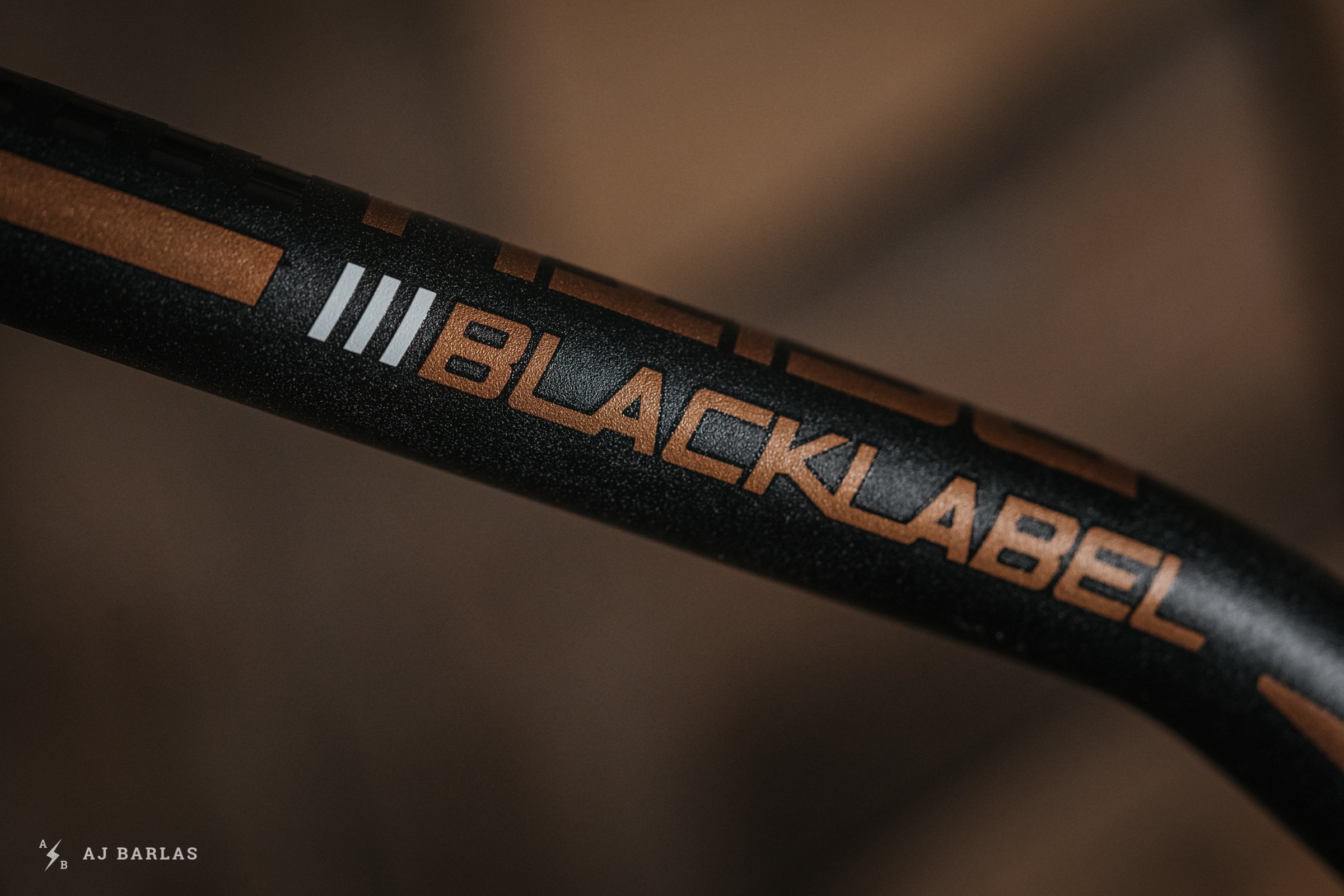
The Blacklabel handlebar is Deity's DH race bar in the 31.8mm diameter.
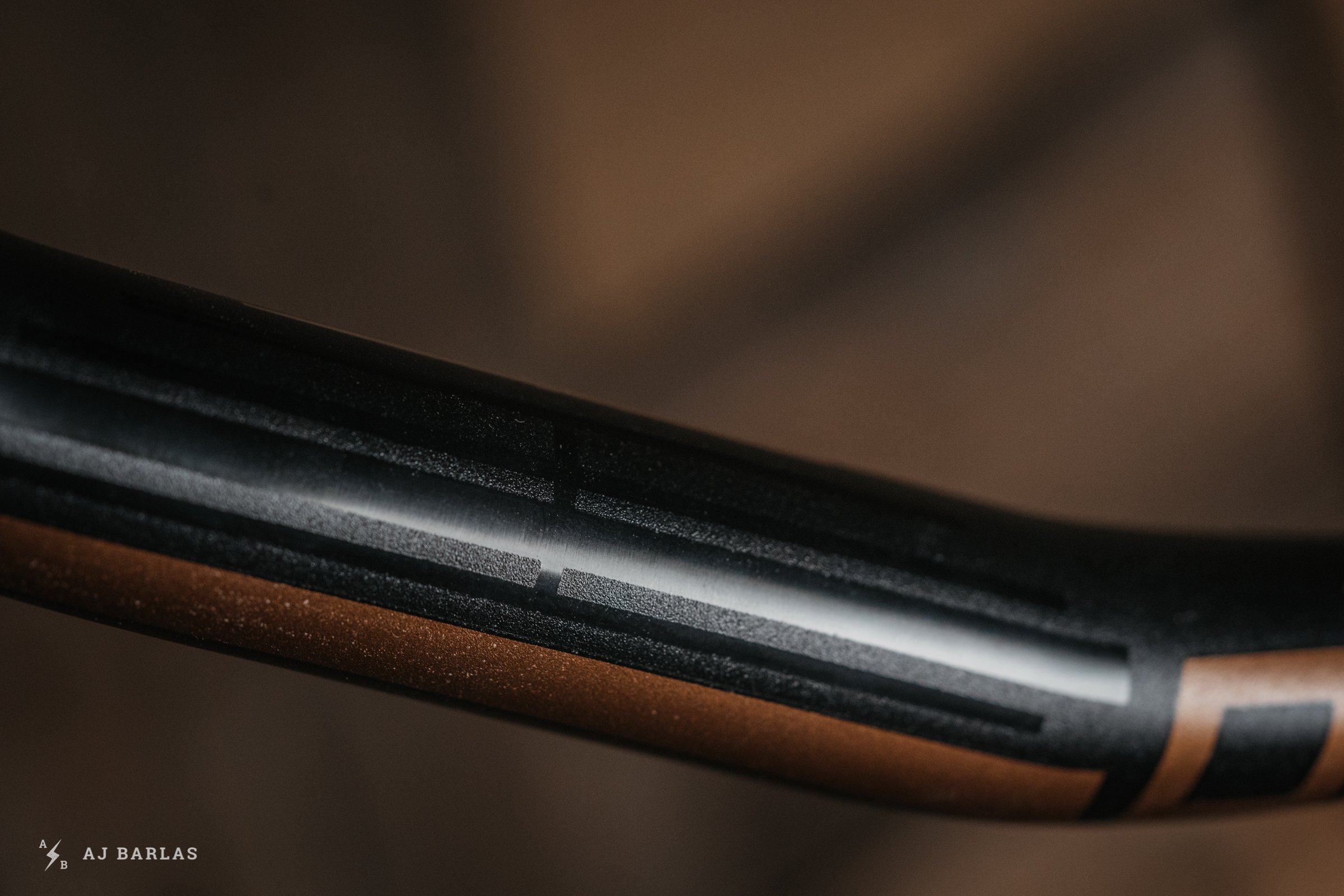
The bar features roll indicators though I've found them somewhat ambiguous.
After years trying 35mm bars on test bikes and a couple on my own, the size has never made a permanent claim to my cockpit. I feel more comfortable on a 31.8mm diameter and see no need for increased stiffness. With brands marketing the bigger is better mantra for bars, and so many OE spec. options featuring the larger clamp interface, it’s no surprise that so many riders get caught on the 35mm bore. Not to mention when there's an influx of new riders.
In the new 35mm range from Deity, the equivalent bar to my preferred Blacklabel is the Racepoint so I'll begin there. From the Racepoint it's onto three other Deity 35mm bars; the Topside alloy bar, and the Speedway and Skywire carbon bars. The Deity Ridgeline 35mm alloy bar was also on the long term Norco Sight I reviewed and I can offer some insight, but the Ridgeline never spent time on an identical setup like the rest. Each handlebar features a 5-degree upsweep and 9-degree backsweep but stock, they vary in width.
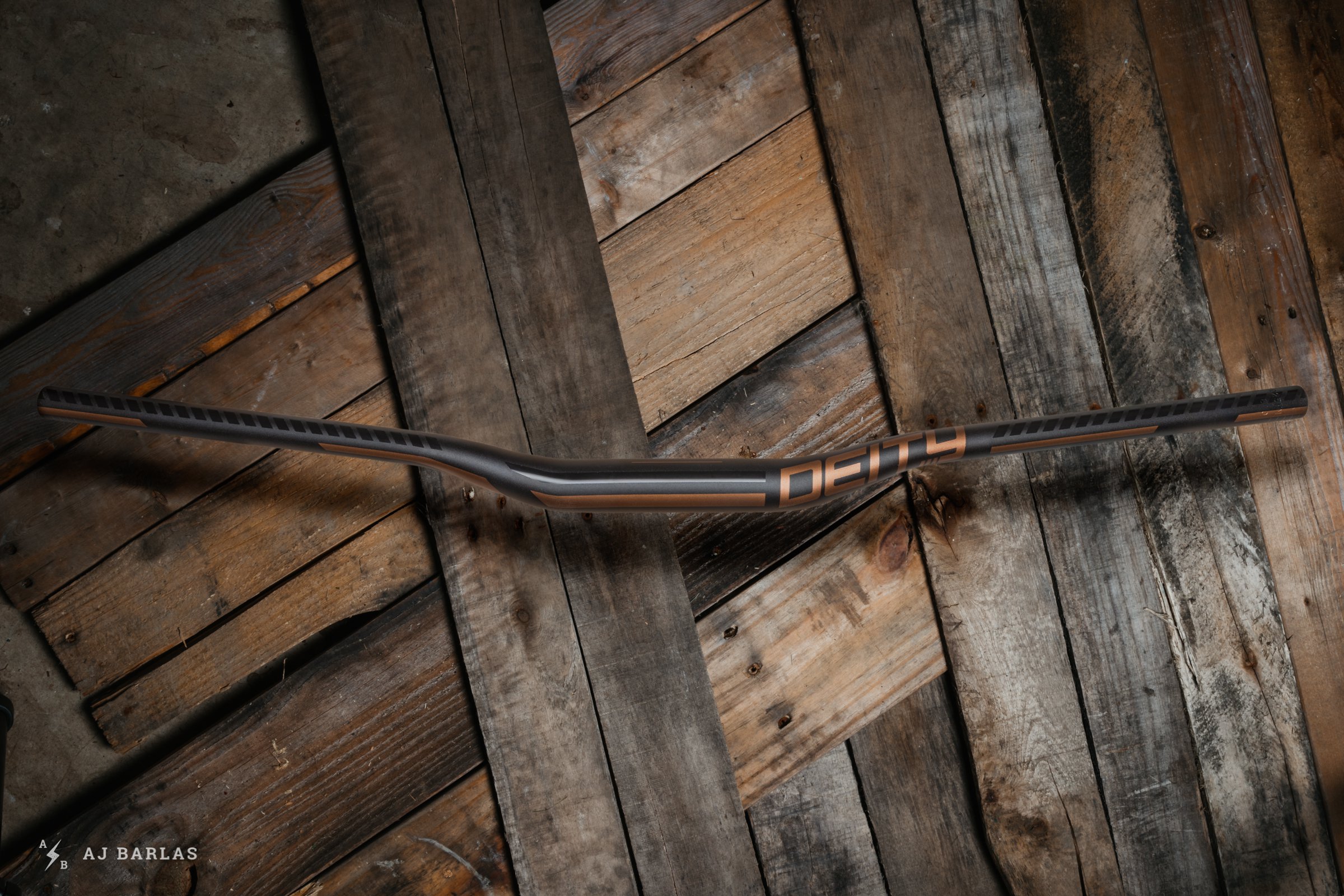
What better place to start a comparison than with what Deity claim has "flex and deflection characteristics designed to match the Blacklabel handlebar."
Deity Racepoint
810mm wide • 25mm rise • 7075 T73 aluminum w/ Gradient Butting Technology • Weight: 323g (cut to 800mm) • 84.99 USD
While the Racepoint bar is claimed as the 35mm equivalent to the Blacklabel, it comes in a wider 810mm width. They felt too wide for me and to keep things consistent I chopped them to my current preference of 800mm. Mounted, the bars looked different. The straight, 35mm section through the stem ran for longer before hitting the rise than the 31.8 diameter section of the Blacklabel. Grabbing the bars with my eyes closed, they felt the same.
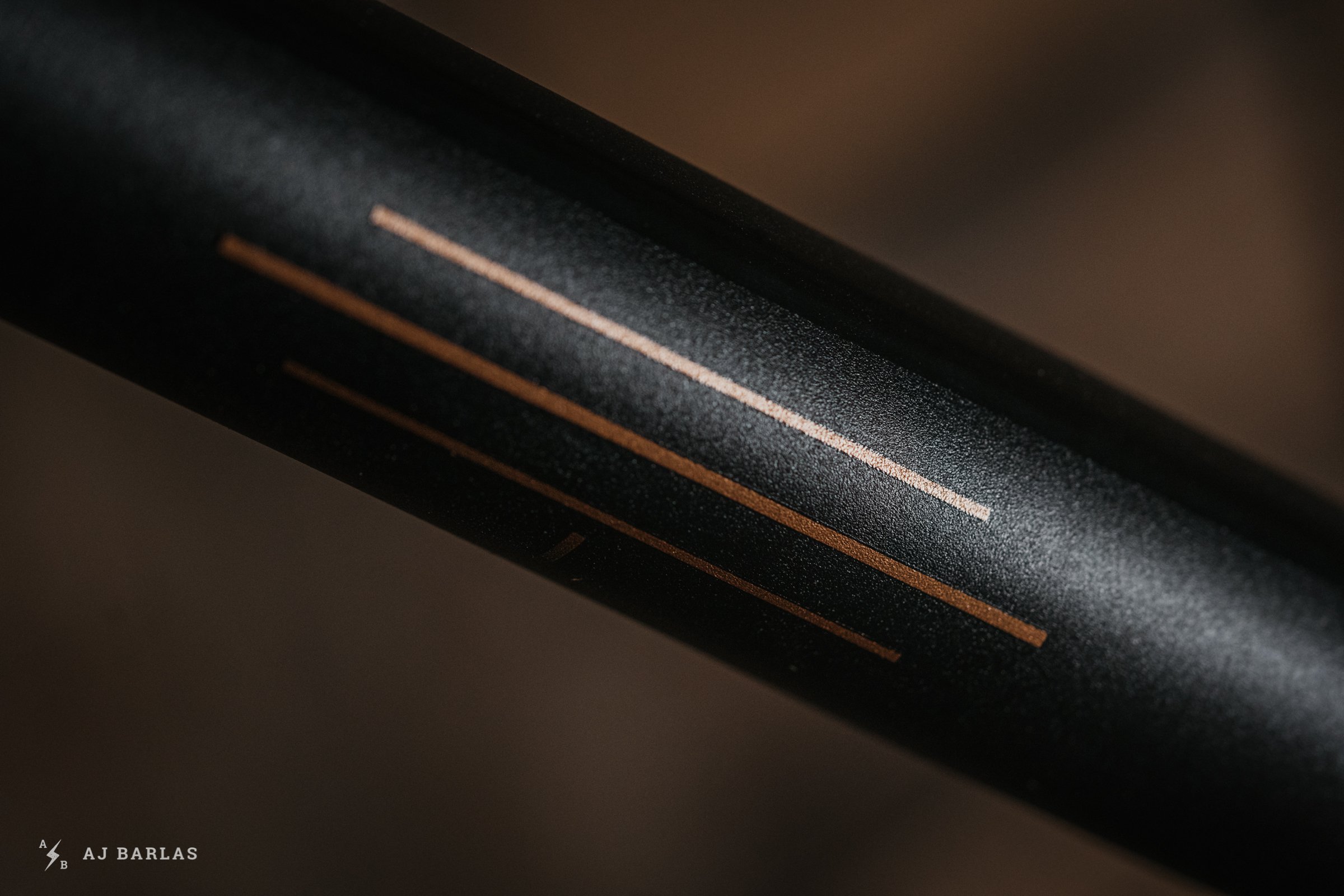
The Racepoint bar has cleaner roll indicators but their placement can still be on the ambiguous side. I'd appreciate seeing more structured indicators here.
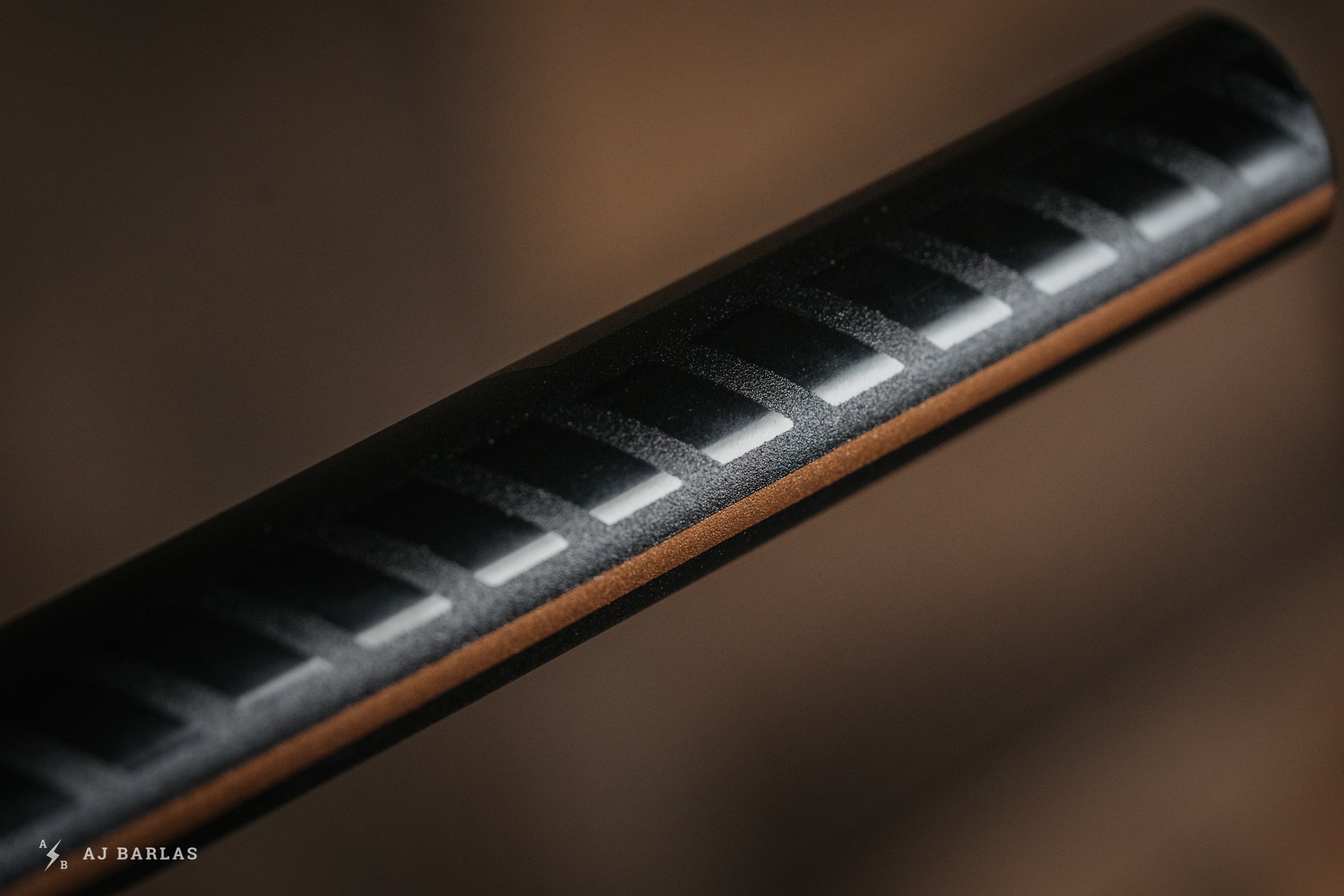
I enjoy the visual simplicity of something like Renthal's Fatbar – they don't try and look fancy. But I do enjoy the attention to visuals and the styling of the Deity bars.
I found these the most comfortable of the 35mm bars in the test. During an average ride they went about their business in the same manner as the Blacklabel – that’s to say they went unnoticed. But occasionally when pushing during long, sustained descents – five minutes or more – my hands lost some strength, with the fatigue growing the longer I pushed on. This was minor and not bad enough to affect brake control. After rides, I didn’t feel beat up from the bar and I could get back on the bike the following day without any signs my hands had ridden hard the day before.
Are they the equivalent of the Blacklabel? They’re really fricken close. If it weren’t for the longer descents available in Pemberton and the Whistler Bike Park, I would've struggled to notice the difference. But it seems the bigger diameter had an impact on something. I can’t be certain if it’s the way vibrations were handled or a slightly different flex. Nevertheless, I haven't experienced the same issue with the 31.8mm Blacklabel bar.
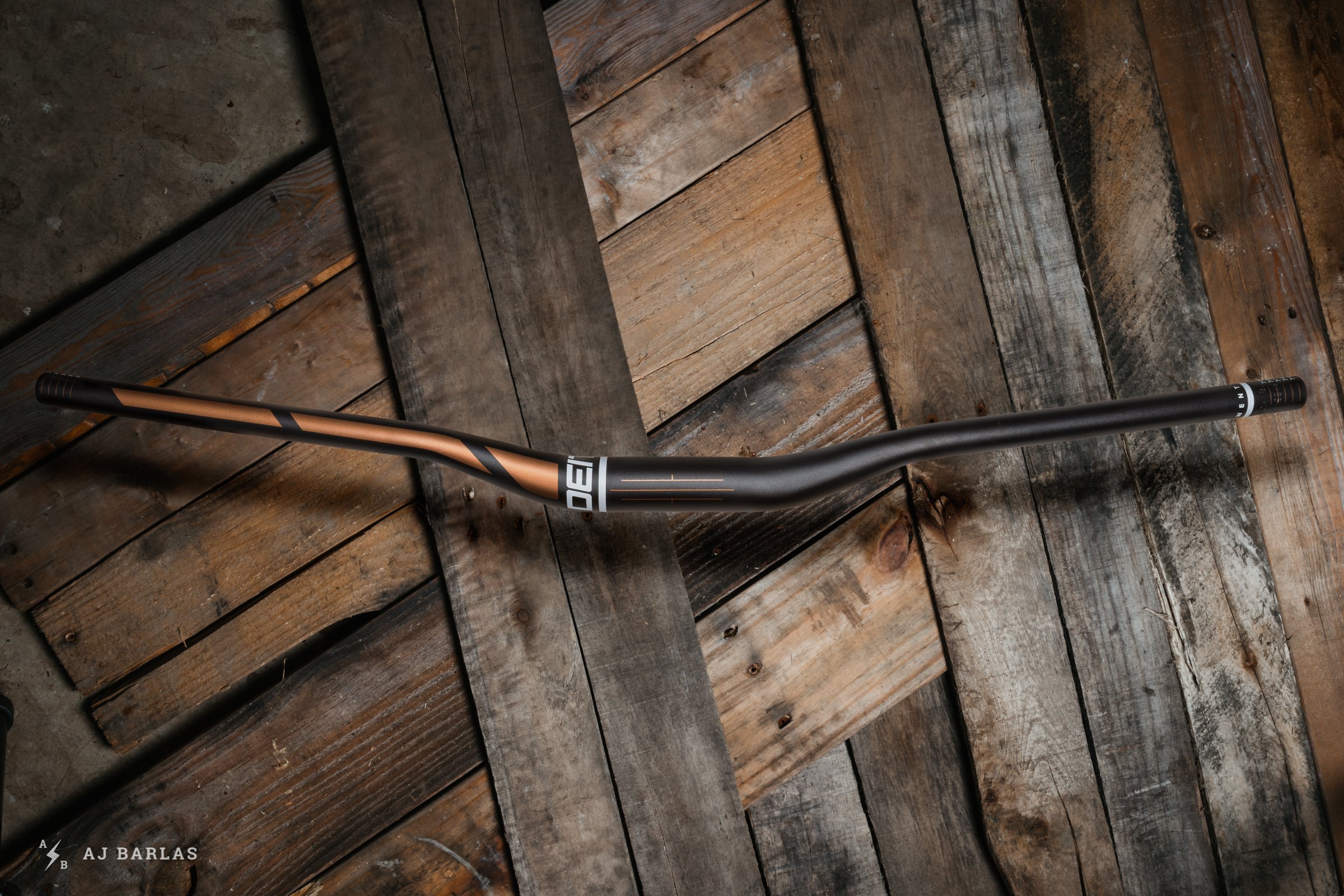
The Topside is Deity's budget bar but it's the different material that grabbed my interest…
Deity Topside
800mm wide • 25mm rise • 2014 T73 aluminum w/ Gradient Butting Technology • Weight: 398g • 56.99 USD
Deity makes the Topside bar as an "affordable option to upgrade your OEM handlebar.” I specifically requested this handlebar because another brand is using the same material with claims it provides a more comfortable ride – although they're in the 31.8mm diameter. At first, I thought this may be true but as with the Racepoint above, I found my hands occasionally losing grip strength toward the bottom of long, rough descents. Where things differed between these and the Racepoint was the Topside left me with sore hands after some rides.
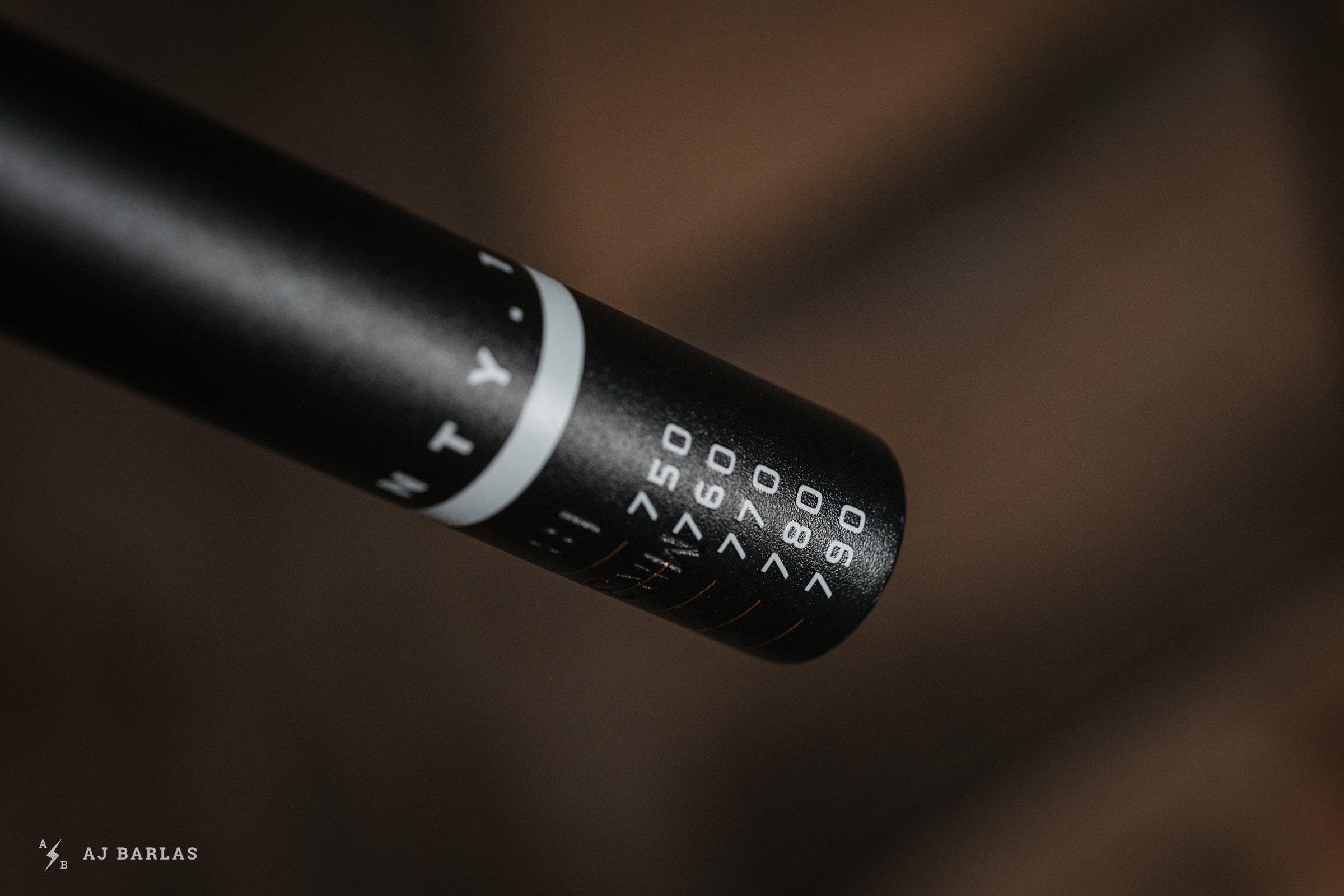
All bars feature indicators to help customers cut them down to a preferred width relatively easily.
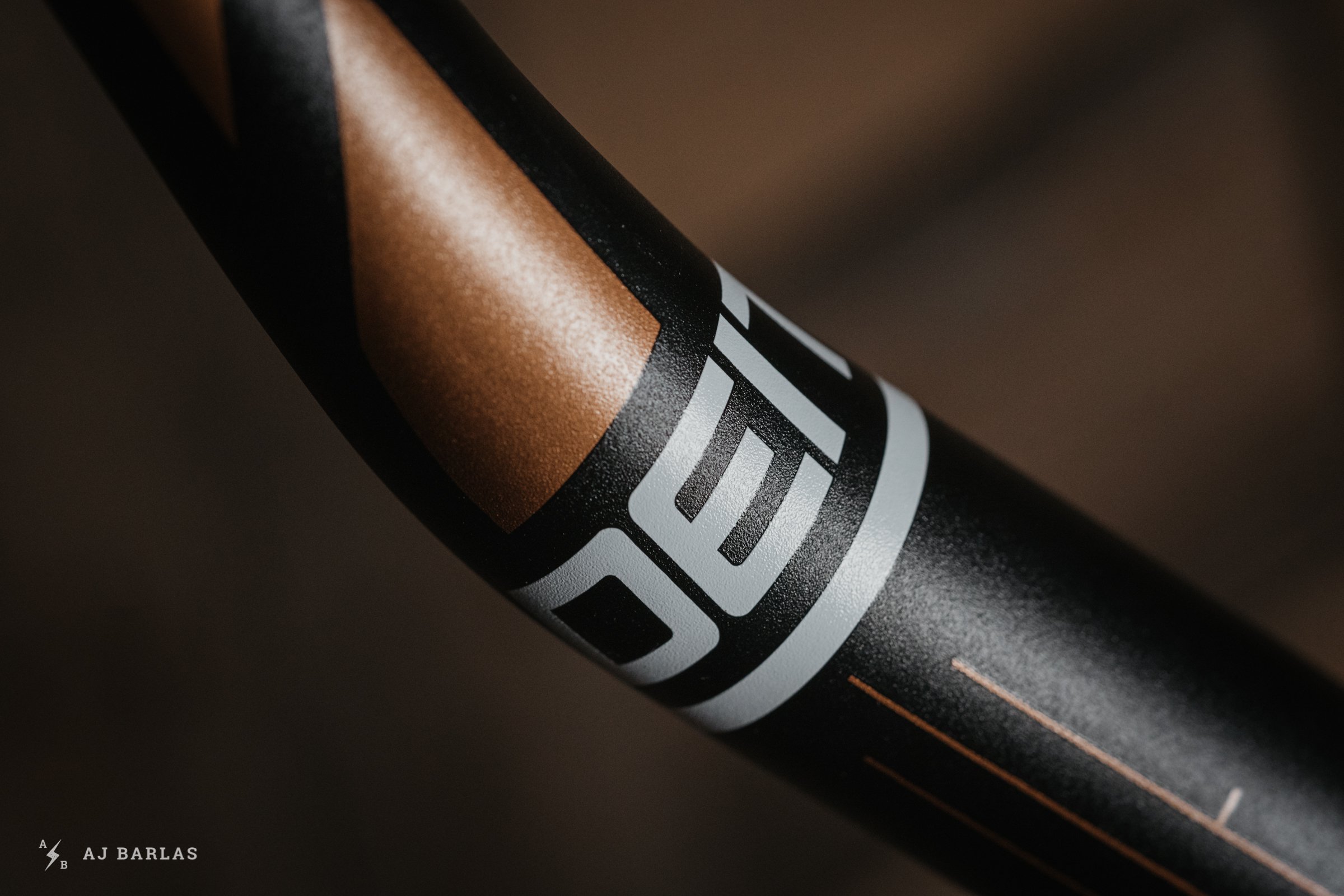
The graphics on the Topside are the most simple of the range, something I did enjoy.
Aside from the occasional hand discomfort and fatigue, I found these and the Racepoint to feel similar on the trail. One wasn’t noticeably stiffer than the other when steering the bike and while the Topside left my hands feeling sore after a solid rip, I didn’t find them noticeably stiffer vertically. The difference felt riding these bars was minimal in the real world. And while the Ridgeline was ridden on a different bike, my experience with them was similar to the Topside.
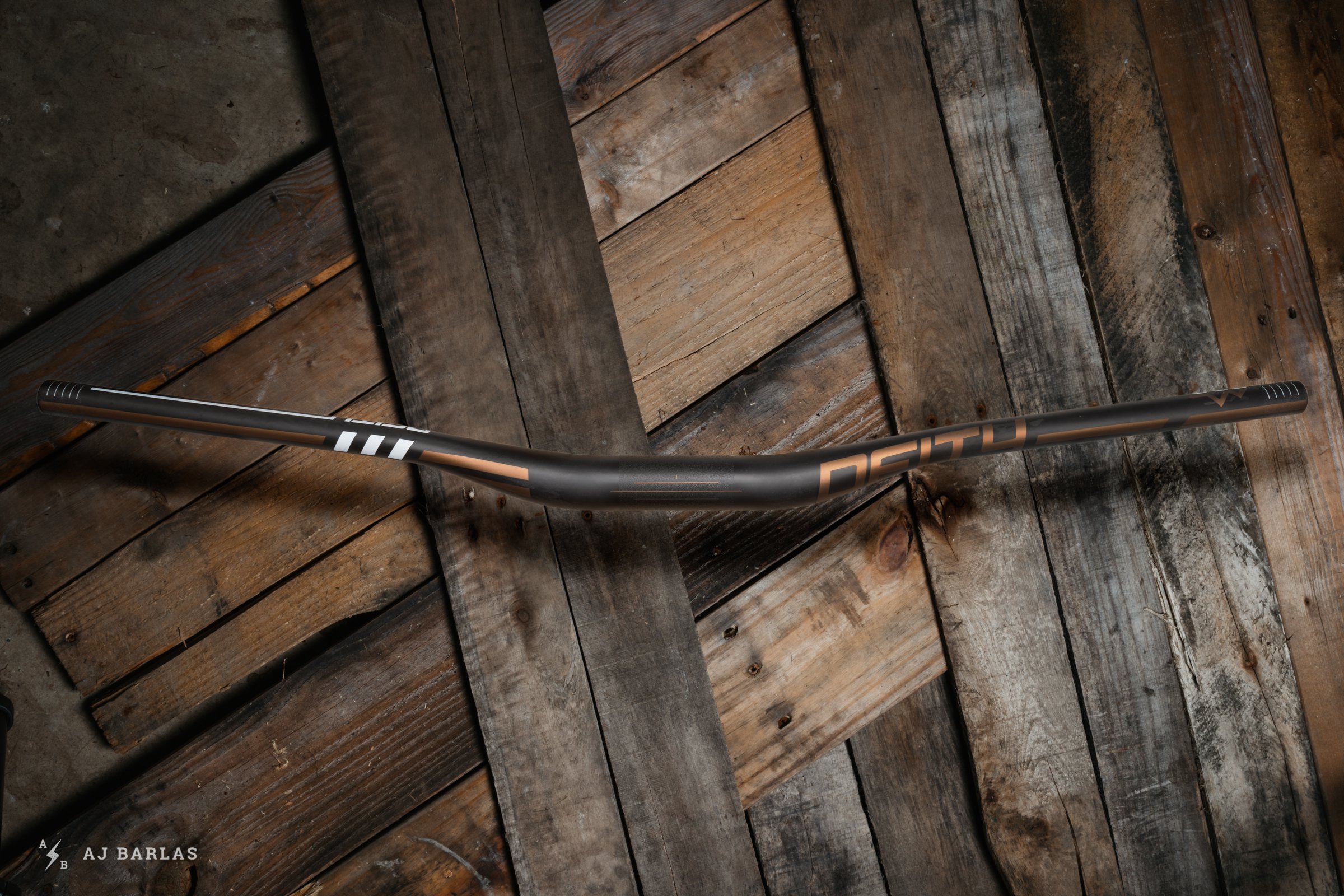
The Deity Skywire carbon bar is built with all-mountain riding in mind and is more forgiving than their carbon DH bar.
Deity Skywire
800mm wide • 25mm rise • Unidirectional Carbon Construction • Weight: 225g • 169.99 USD
The Skywire is Deity’s 35mm carbon all-mountain/enduro trail bar. As with others, Deity extended the width from the 787mm of similar bars in their 31.8mm range to 800mm. Holding the bar on its own, the lighter weight was obvious but on the bike, I can’t say I noticed it. Switching from the alloy 31.8mm Blacklabel bar, the extra stiffness was clear though. That stiffer contact point translated to my hands feeling some fatigue after long, rough descents, again above five minutes long.
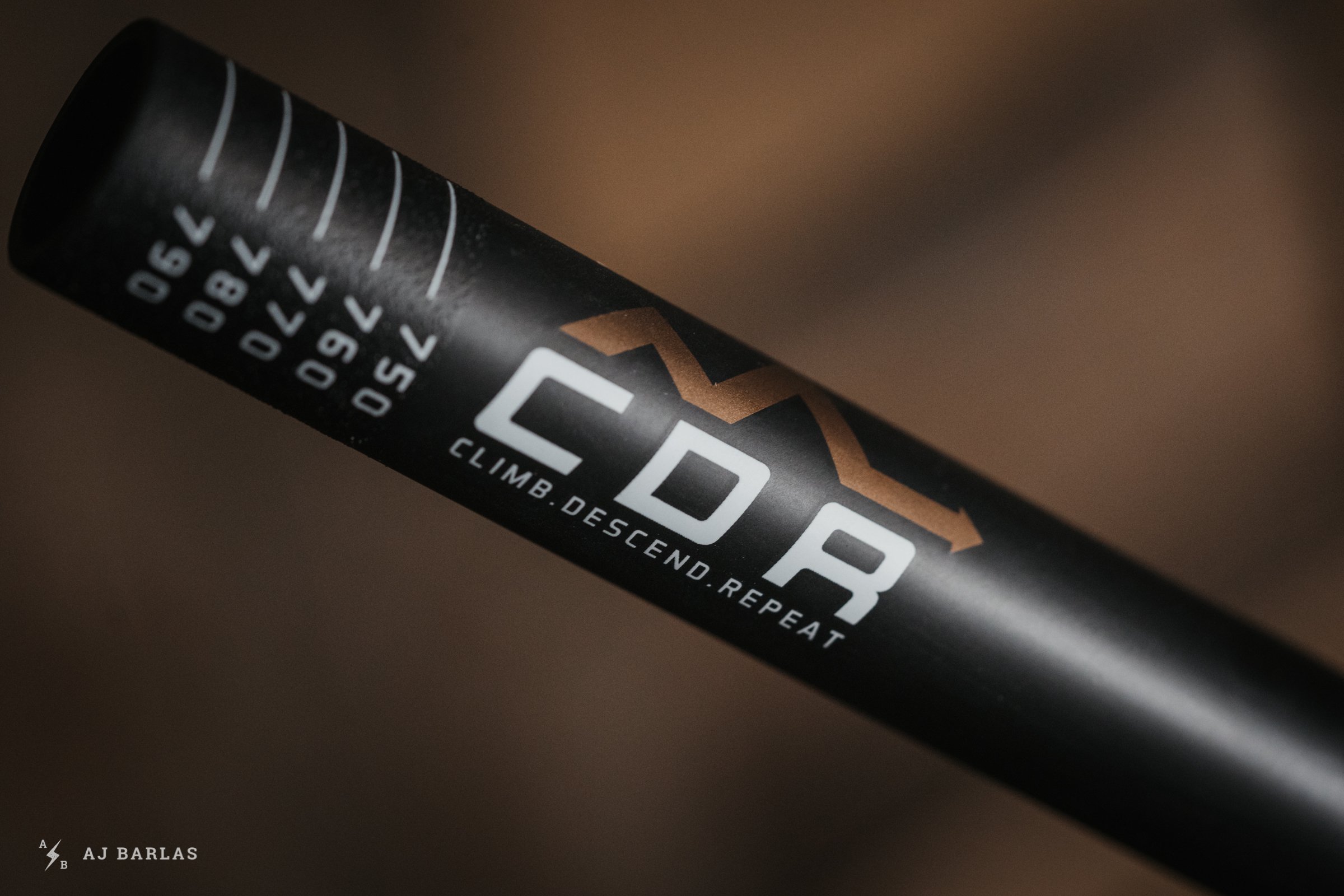
A mantra I can get behind…
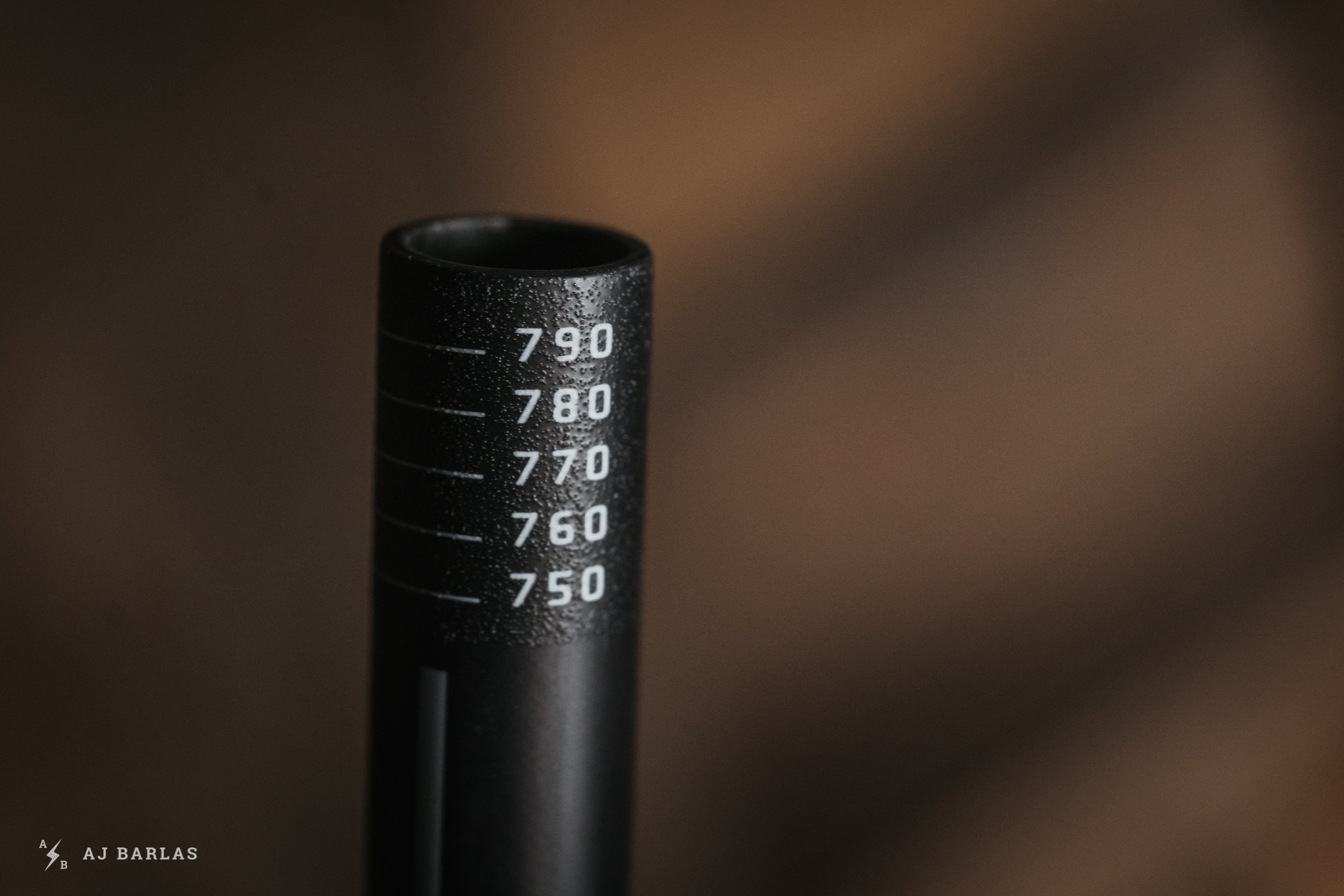
The carbon bars feature a textured grip end to help keep grips in place.
On rides where a non-stop descent would max out around the three and a half-minute range, I didn’t have any issues with grip fatigue. Carbon's ability to tune out some of the trail noise seems to have helped here. Switching back and forth between these, the alloy Topside and Speedway confirmed the bar fit perfectly in the middle. These felt stiffer steering the bike than they did when taking an impact. Looking for more responsive steering than the 31.8mm Blacklabel and seeking some of that carbon damping? The Skywire is a good option.
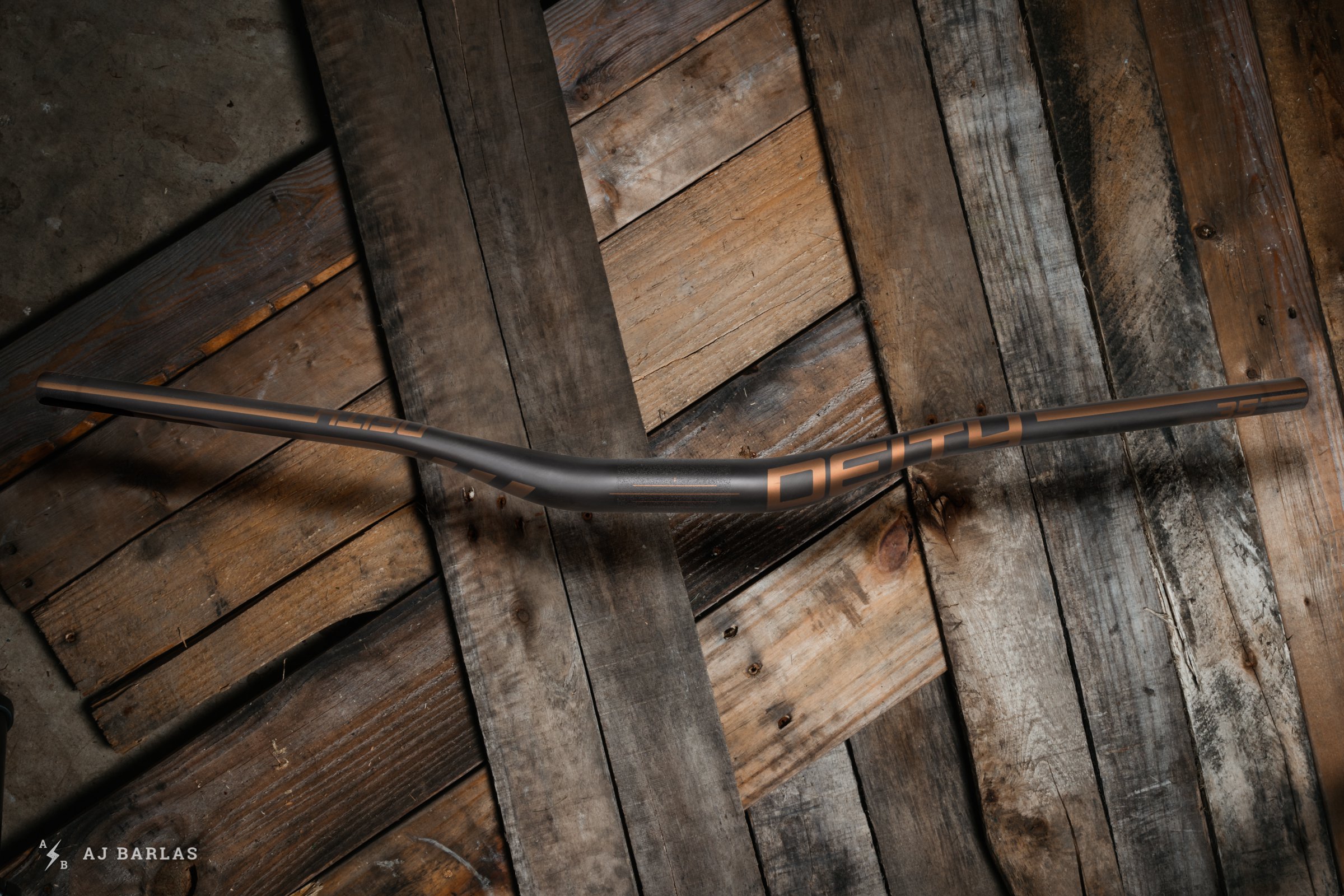
The stiffest bar I've ever grabbed hold of. If you enjoy a very direct response and firm feel, this is the bar.
Deity Speedway
810mm wide • 30mm rise • Unidirectional Carbon Construction • Weight: 254g (cut to 800mm) • 169.99 USD
Of all the handlebars in the test, the Speedway was the most eye-opening. After switching the Blacklabel for these, the firm feel was remarkably obvious. They were significantly stiffer than the Skywire bar too, and I found my hands and forearms growing tired even on short local trails that I ride weekly. The extra firmness at the hands was pronounced and it threw off my feeling for the rest of the bike, with the bar noticeably less pleasant than components elsewhere.
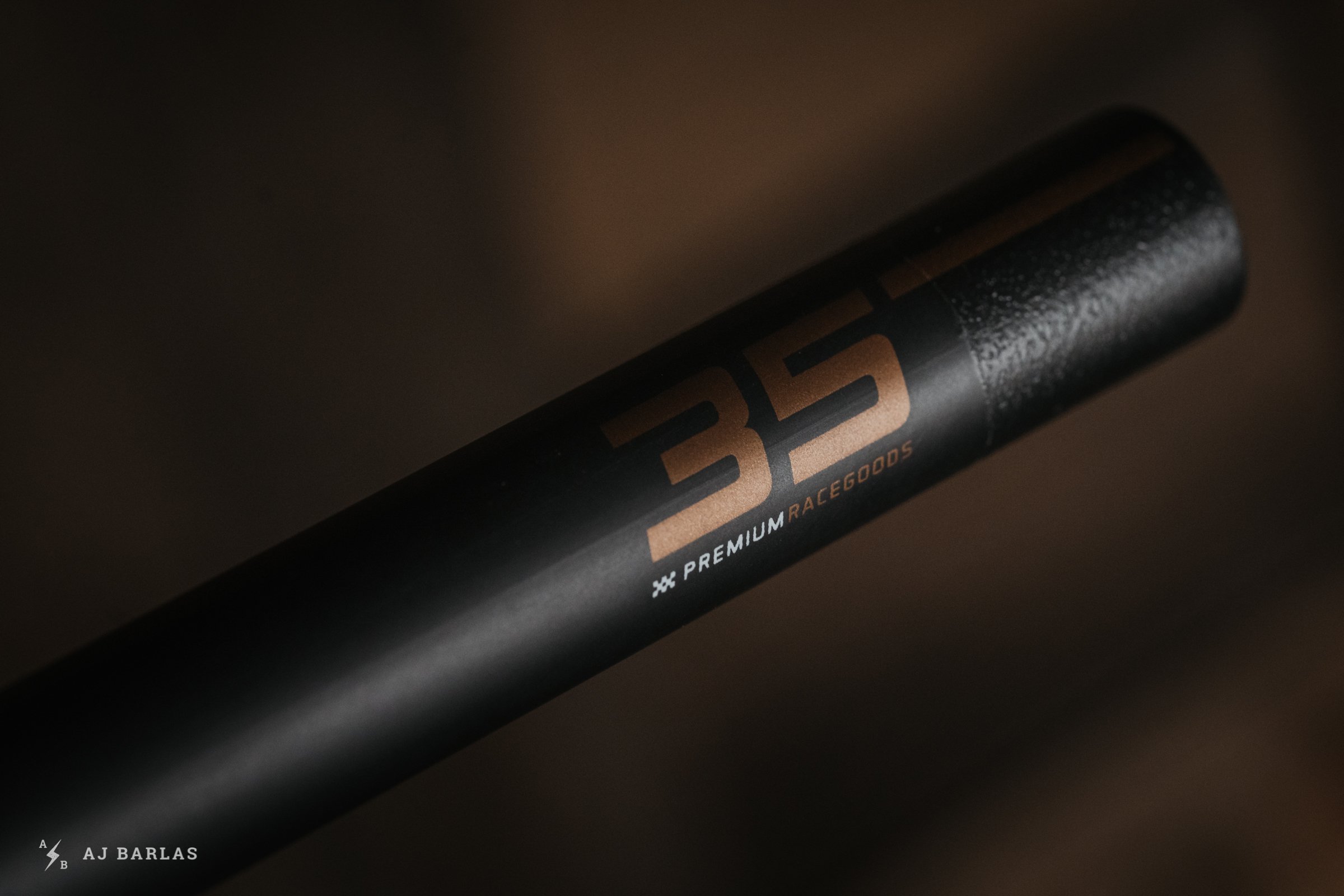
These are targeted at the aggressive downhill and enduro racer. The carbon equivalent to the Racepoint.
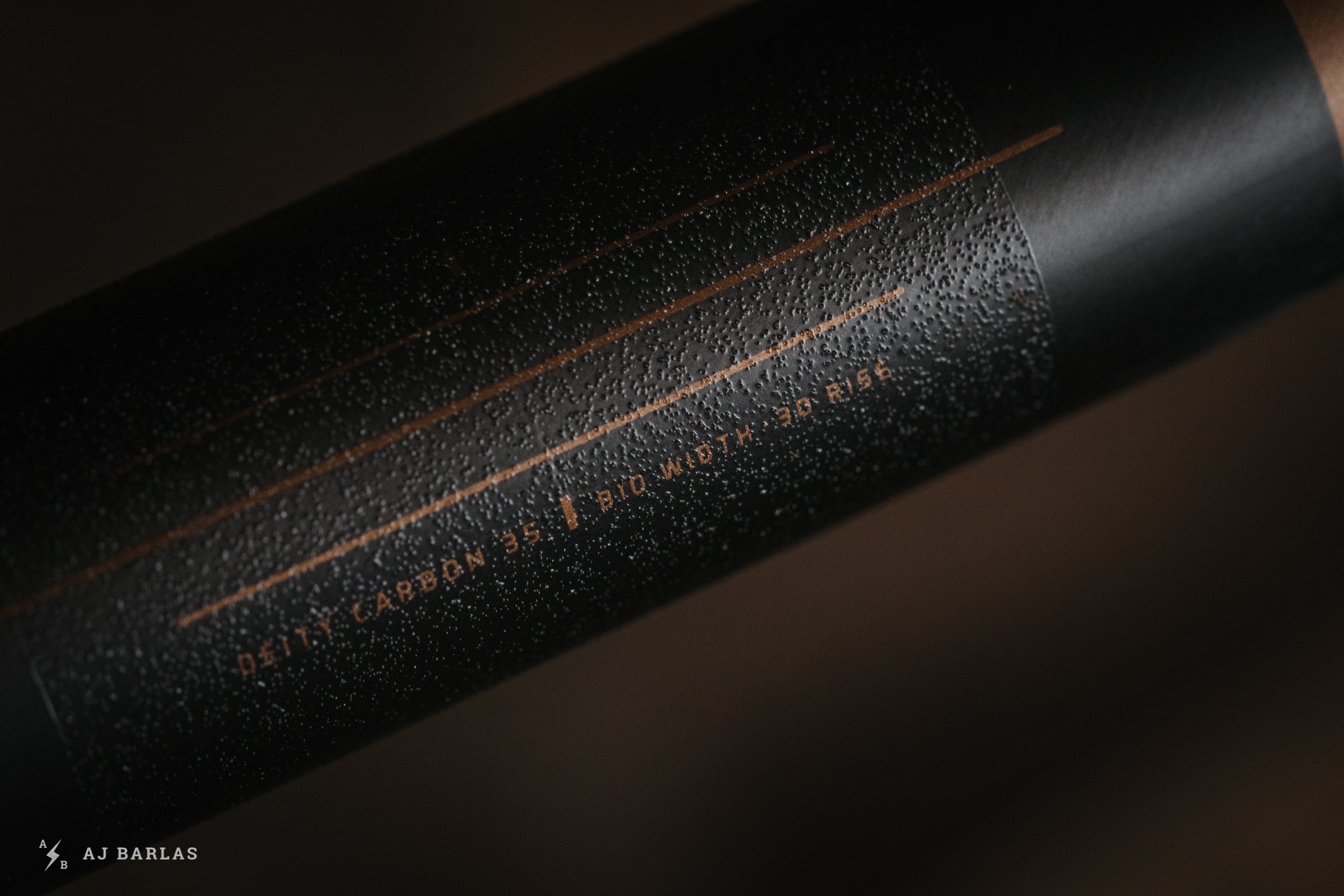
Carbon bars feature textured non-slip clamp interface. These were the only bar to differ in rise.
For bigger heavier riders on an already stiff setup, this may not be an issue but riders who enjoy a more comfortable ride will likely find the Speedway overwhelmingly firm. In the early days of the Whistler Bike Park, I would occasionally get “the claw” and lose grip strength from hand and arm fatigue. It's been many years since experiencing that and I’ve never noticed it on the slower speed trails around Squamish. Anyone looking for the stiffest bar they can with Deity's most often used geometry, the Speedway has your name on it.
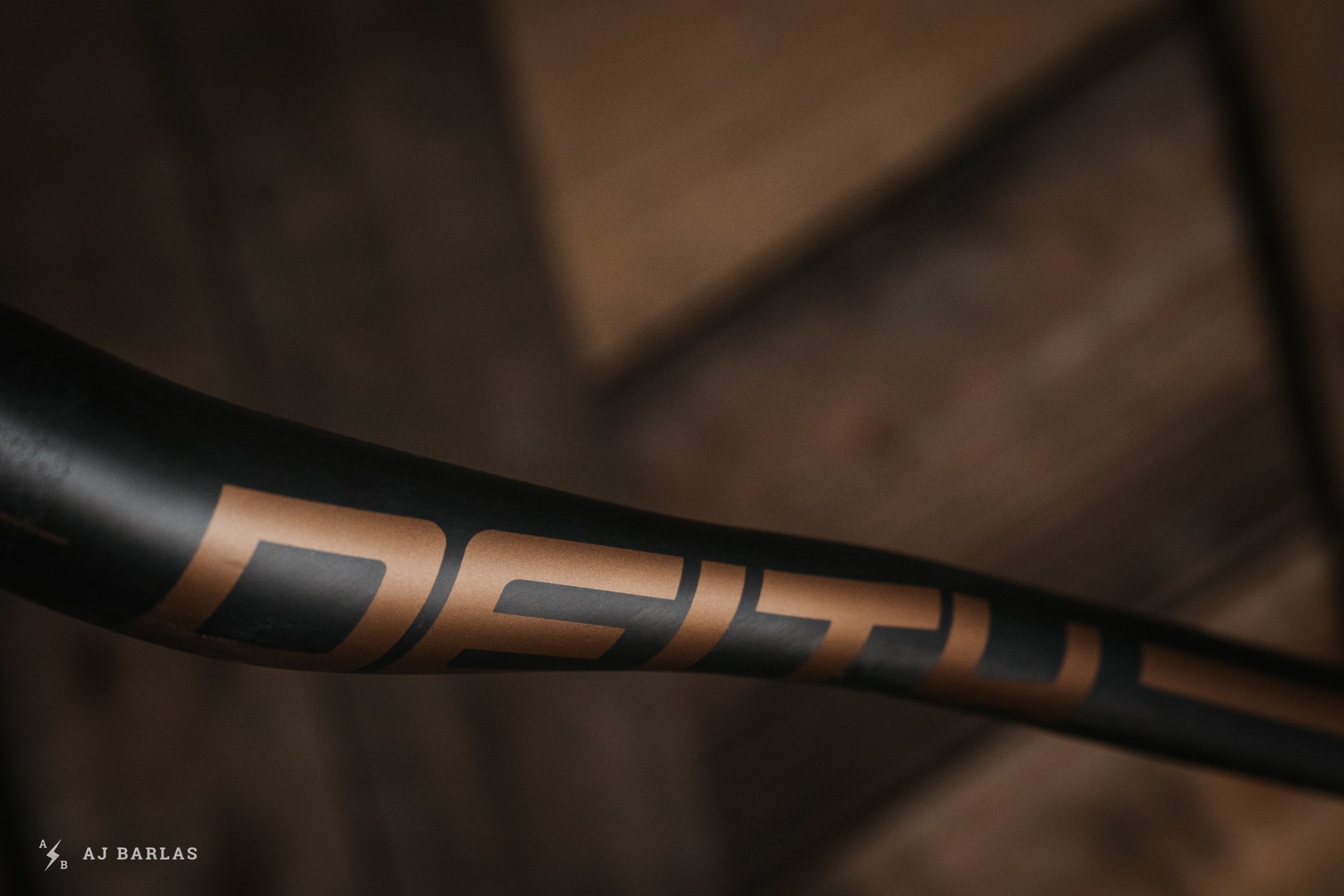
If you're keen on a bit more backsweep meshed with a 5-degree upsweep, Deity's range provides a good mix of options.
Verdict
There’s no point manufacturing bars with different names and identical characteristics. The 35mm range from Deity certainly caters to the needs of different riders while preserving the geometry.
After eight months of testing back and forth between bars, the Racepoint is still on my bike. For general riding around home and even in the Whistler Bike Park, they’re close enough in feel to my beloved Blacklabel handlebar that I can run them. They do, however, cause some discomfort when pushing longer laps in the park or Pemberton and I will eventually switch them for the 31.8mm Blacklabel. With those, I can ride day in, day out, longer uninterrupted runs or short, rough stuff and not experience any hand issues. But not everyone wants to run 31.8mm bars and Deity's selection provides variety for riders to grab on to whatever they prefer.
There's more information on Deity’s 35mm range of handlebars over on their website.
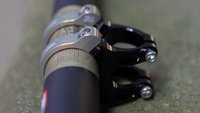
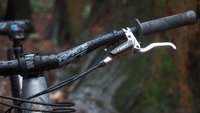
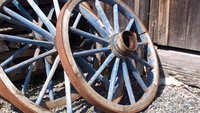
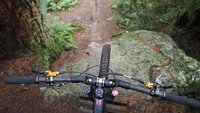







Comments
Allen Lloyd
3 years, 8 months ago
35mm isn't as pervasive because it is an inferior product. It is stiffer, which for 99.9999% of riders is worse not better. For bars with little to no rise or sweep they are brutal on your hands. I rode the OEM Race Face bar on my Hightower for a year and my wrists couldn't do it a second year. Switched to a Renthal and it is miles better, but still not as comfortable as a smaller diameter bar. If I wasn't so cheap I would swap the bar and stem to 31.8, but for now I just ride the 35.
Reply
danimaniac
3 years, 8 months ago
I'd like to know how these compare to the one up bar...
Reply
Cee Cee
3 years, 8 months ago
Handlebar shootout: Blacklabel 31.8--AJ's clear favorite--vs. OneUp 35x35x800mm vs. Enve M9 31.8x50x810mm vs. Da Package 33x20x800mm vs. Syncros Hixon in its highest and widest. Severe first world problems. I don't include USA for our barbaric health care commerce and will stick to M9 until AJ says otherwise. It's plusher than Renthal alloy 35mm, NextR 35mm, and I already own it.
Reply
RNAYEL
3 years, 8 months ago
After riding carbon 35mm bars for the last 4 years, I'm back on 31.8. Picked up some Terrain Control bars on the recommendation of EarleB and I didn't expect the comfort difference to be so pronounced.
As mentioned, everything else on the bike is stiff and something has to give, unfortunately, it was my wrists.
Reply
ackshunW
3 years, 8 months ago
Oo that Terrain Control bar is very very nice. Never heard of the company. Price is right too!
Reply
AJ Barlas
3 years, 8 months ago
Those Terrain Control bars are interesting! Rnayel, are you running them cut? I found this statement on the product page interesting too: “keeping the more flexible 31.8mm clamp diameter to help with absorbing vibration better.” 🤔
Reply
JVP
3 years, 8 months ago
I don't understand why 35mm exists, and I still don't trust carbon bars, even though I'm loving plastic-fantastic components in some other spots on my bike.
For that matter I still bin my aluminum bars every 12-18 months for freshies. Literally everything else on my bike I run till it dies. Is this just an old-school PTSD thing from riding in the 90's, or do others still do this?
Reply
Vik Banerjee
3 years, 8 months ago
I don't replace carbon or metal bars unless they are damaged. Realistically my tastes change so I am not riding the same bar for 10 years straight, but 4-5 years would be likely.
Reply
Velocipedestrian
3 years, 8 months ago
35mm exists because 31.8 looks too skinny next to a fat carbon frame.
Reply
Andy Eunson
3 years, 8 months ago
I believe 35 came from road. Deda came up with a 35 bar and stem which Andre Greipel used. His nickname is the Gorilla. Road sprinter. Those guys will hit 2000 watts in a sprint so perhaps stiffer for them is better.
Reply
Velocipedestrian
3 years, 8 months ago
I'll buy that, I used to work in a shop that serviced the NZ Olympic track teams bikes. That young Eddie Dawkins chap could certainly flex a bar.
Reply
Geof Harries
3 years, 8 months ago
When I first got on 35mm bars in 2016, I immediately noticed a difference in stiffness and response but not a significant downgrade in terms of comfort. To me, 35mm is superior.
I am a bigger guy and appreciate the extra strength. Having broken or bent a few handlebars myself in the past 25 years I like the larger diameter stuff.
I know that bars from the early 90s aren't the same as 31.8mm bars now, but I do notice and appreciate the extra chunk.
Reply
Brumos73
3 years, 8 months ago
I have the Skywire carbon bars with 15mm rise at 760mm on my downcountry bike and the One Up carbon 35mm rise at 780mm on my trail bike. Honestly, i don't notice a difference in terms of my arms/hands fatiguing however i do find the 35mm rise bars more comfortable because of the riding position i'm in. More upright and less weight/pressure on wrists/hands.
I find running the correct/incorrect tire pressure has a greater influence on arm/hand fatigue.
Reply
Cameron Taves
3 years, 8 months ago
This comment has been removed.
Sanesh Iyer
3 years, 8 months ago
Rain jackets, night lights, winter shoes, and carbon bars are the only products that let me ride more (carbon bars = warmer hands for me). Happy to spend the dough. Would be cool to see the frequency response of various bars. Pretty sure there's a fair amount of work done correlating vibrations to fatigue. Maybe there's a way to optimize bar layup/diameter/etc around that.
Reply
mrbrett
3 years, 8 months ago
I remember a while ago reading a PB article about hand vibration and that if you measured the vibration at the grips, and compared it to occupational health and safety requirements, then the amount of vibration at your hands can easily be worrisome.
Reply
AJ Barlas
3 years, 8 months ago
True. I’ve read quite a bit on the vibrations in mtb and cycling and how bad long term exposure—years of riding—can be for us. There are more and more studies into it, it seems and the findings aren’t good.
Reply
Bushpilot
3 years, 8 months ago
From what I can tell, bar comfort seems to be pretty subjective. Here's what outdoor gear lab had to say about the Deity Blacklabel bar:
"They are plenty stiff even with a 31.8mm bore/clamp diameter, and the 800mm width provides ample leverage. Steering feels direct and precise, but maybe a touch too little compliance leaves these bars on the slightly uncomfortable end of the spectrum compared to bars that reduce vibration better like the Spank Oozy Vibrocore or Ibis Adjustable Carbon, both of which are designed around the 31.8mm clamp diameter. More comfortable 35mm options include the Santa Cruz Bicycles Carbon and RaceFace Next R bars.
We liked the sense of control provided by the stiffness of these bars, but couldn't ignore the hand fatigue generated by them over relatively short runs. They are stiff, and steering feels very direct with plenty of leverage for muscling the bike around at speed or through rock gardens. It didn't take long, however, for our testers to start losing feeling in their hands with the feedback that came straight through them."
I have a OneUp bar and a Rental Fatbar Carbon (35mm clamp). The Renthal bar definitely feels more "precise" when it comes to steering input. But I don't notice much difference in comfort between the two. Maybe I'd notice more of a difference without Cushcore, good suspension and low-ish tire pressures...
Reply
Andy Eunson
3 years, 8 months ago
For my 140 ish pounds, 33 mm grips, 2.5-2.4 tires at low psi, soft forks are infinitely more important than bar “compliance”. Back in the day we had slim grips because Tomac said, 2.1 was a fat tire with tubes pumped too hard, rim brakes caused a death grip because they stunk. That my friends, in winter on the north shore is the definition of hand cramps and arm pump. Maybe if I was a lot heavier on a wider bar (740 for me) I’d notice it. Stiffness or compliance is the sum of all the components. I think to judge bar compliance one really needs machines to test and compare that.
Reply
Agleck7
3 years, 8 months ago
Aj - have you tried the Spank Vibracore bars? I know you enjoyed the wheels so those would be an interesting comparison.
Reply
AJ Barlas
3 years, 8 months ago
I haven’t yet but I’ve spoken with Spank earlier this year and will be checking some out once they can spare some. They’re selling out constantly at the moment. Like some other brands.
Reply
Agleck7
3 years, 8 months ago
I haven't done any specific testing but haven't experienced any hand soreness on mine. now that Andrew convinced me to try push on grips it's about to get next level ;)
Reply
lewis collins
3 years, 8 months ago
AJ - do you have an opinion on the differences between the Blackout and a Renthal Fatbar 31.8? other than the obvious 2' sweep difference. Having ridden Ali Renthals for many years now i've never had a problem but i'm interested if there's a considerable or minimal fatigue difference...
Reply
AJ Barlas
3 years, 8 months ago
Hey Lewis. It’s been ages since I switched from the Renthals so I’d have to toss them back on and see. From memory, the Renthals were a bit stiffer than the Blacklabel but I don’t recall having hand issues. Again, I’d need to test them back and forth on my current bike to confirm any thoughts though. I’ll see if I can get this done in the near future.
Reply
Please log in to leave a comment.